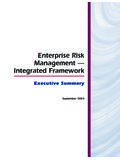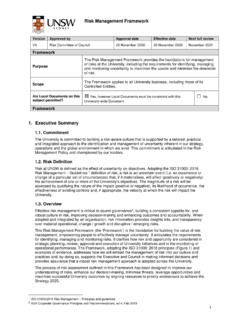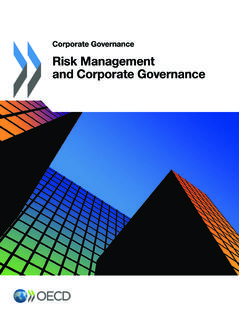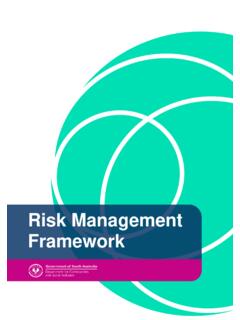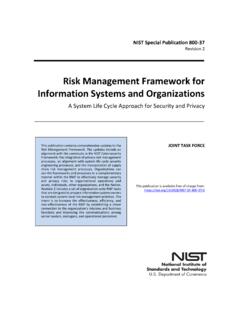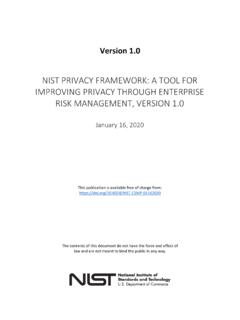Transcription of An Overview of the Risk Management Process
1 1An Overview of the Risk Management Process2016 Department of FinanceCOMCOVER INFORMATION SHEETThis information sheet is intended to assist Commonwealth officials at the following levels: Foundation level: All officials, regardless of level or role, are required to understand basic risk Management concepts and how risk is managed in the Commonwealth. Generalist level: Officials, regardless of level, whose role requires them to engage with and apply their entity s risk Management framework to successfully deliver outcomes. The risk Management Process described in AS/NZS ISO 31000:2009 Risk Management Principles and Guidelines is one way of achieving a structured approach to the Management of risk. Consistently implemented, it allows risks to be identified, analysed, evaluated and managed in a uniform and focused 3100 recommends that risk Management be based on three core elements : a set of principles that describes the essential attributes of good risk Management ; a risk Management framework that provides a structure for risk Management ; and a risk Management Process that prescribes a tailored, structured approach to understanding, communicating and managing risk in practice.
2 An Overview of the Risk Management Process Drawn from the AS/NZS ISO 3 000:2009 FrameworkProcessPrinciples Creates value Integral part of organisational processes Part of decision making Explicitly addresses uncertainty Systematic, structured & timely Based on the best available information Tailored Takes human & cultural factors into account Transparent & inclusive Dynamic, iterative and responsive to change Facilitates continual improvement and enhancement of the organisationMandateandcommitmentDesign of framework to manage riskContinual Improvement of the frameworkImplement risk managementMonitoring and review of the frameworkEstablishing the ContextRisk IdentificationRisk AnalysisRisk EvaluationRisk AssessmentRisk TreatmentMonitoring & ReviewCommunication & ConsultationEMBED2An Overview of the Risk Management Process2016 Establish the contextIn order to understand and manage risk, it s first necessary to understand your entity s objectives and operating environment.
3 Establishing the context is the first of the seven risk Management steps where the objectives and influences of the risk Management Process are first activity in establishing the context is to agree and define the objectives of the entity or the activity being considered. Objectives can include those which are both explicit (those objectives that are well defined, for example we will increase client satisfaction feedback by 5 percent ) and implicit (those objectives that might be undocumented but are expected, for example we will obey the law ).Secondly, it is important to identify relevant stakeholders. The most important stakeholders include organisations which may expose the entity to risk, are exposed to an entity s risks , or be able to help an entity manage are three other elements that are important to consider when establishing the context for a risk assessment: The external context - the environment in which the entity operates and seeks to achieve its objectives including policy, operational, cultural, political, people, environmental, legal, regulatory, financial, technological and economic factors.
4 Other things to be considered include key drivers and trends that impact upon the objectives, and the relationship with, and expectations of, external stakeholders. The internal context - includes those factors within the entity that are relevant to the risk assessment. This is important as risk assessments will be most effective when they are linked to the objectives of the entity or activity under assessment. Factors typically considered in the internal context include the entity s strategic objectives, organisational capabilities and culture. The risk Management context - this defines the goals and objectives of the risk Management activity including how it is to be undertaken, who is responsible for each component and what is in identificationThe aim of this step is to develop a comprehensive and tailored list of future events which could be uncertain, but are likely to have an impact (either positively or negatively) on the achievement of the objectives - these are the risks .
5 risks need to be documented including key elements such as the risk event, the potential cause and the potential impact should the risk be identification of potential risks is critical to the success of any risk assessment. It is important not be too narrow or constrained. Often referred to as a failure of imagination , care needs to be taken to ensure that the identification Process does not just focus on today s challenges but rather also considers a diverse range of sources including risk events that are emerging or in the is important to identify actions, scenarios, events and other external agencies that may give rise to risks . For each risk identified ensure that its source or cause is well understood and number of techniques can be used during risk identification and assist in the discovery Process . These can be sophisticated and highly structured, or more informal, depending on the purpose and context of the assessment being undertaken.
6 Common techniques include the use of risk categories or linking risks to each objective identified in the context setting phase. Another method is to begin thinking of the threats and opportunities the entity faces, and use these to identify relevant Overview of the Risk Management Process2016 Risk analysisRisk analysis establishes the potential impact of each risk and its likelihood of occurrence. The combination of these two factors determines the severity of the risk, which may be positive or negative. Although there are many ways to achieve this, a common approach is to use a matrix or risk heat map . Consequence and likelihood are plotted on the two axes of the matrix, with each corresponding cell assigned a level of severity. Illustrated below is an example of a simple risk severity Risk SeverityLikelihood/ ConsequenceInsignificantMinorModerateMaj orSevereAlmost CertainLikelyPossibleUnlikelyRare9113410 18721256 The specific matrix employed may be defined in an entity s risk Management framework and should be considered and agreed in the establish the context step.
7 Whilst entities may use different processes for analysing risk, it is important that each entity ensures all risks within its organisation are assessed consistently. Where risks are shared between organisations, good communication is required to ensure each stakeholder understands the severity of the evaluationRisk evaluation determines the tolerability of each risk. Tolerability is different from severity. Tolerability assists to determine which risks need treatment and the relative priority. This is achieved by comparing the risk severity established in the risk analysis step with the risk criteria found in the likelihood and consequence criteria already its simplest, an entity might decide that risks above a certain severity are unacceptable, and risks below this are tolerable. More sophisticated approaches might assign risk acceptance delegations for risks of increasing severity to officials of different levels of on tolerability should also be made after considering the broader context of the risk including the impact of the risk upon other entities outside of the organisation.
8 Treatment decisions should consider financial, legal, regulatory and other requirements. Ultimately though, the considered and informed acceptance of risk supports decision making and is essential to entity performance including the achievement of Overview of the Risk Management Process2016 Risk treatmentRisk treatment is the action taken in response to the risk evaluation, where it has been agreed that additional mitigation activities are treatment is a cyclical Process where individual risk treatments (or combinations of treatments) are assessed to determine if they are adequate to bring the residual risk levels to a tolerable or appropriate level. If not, then new risk treatments are generated and assessed until a satisfactory level of residual risk is treatment will be most effective where it is tailored to the requirements and capabilities of the entity and can include strategies such as: Avoiding the risk entirely by not undertaking the activity Removing a source or cause of the risk Sharing the risk with other parties Retaining the risk by informed decision Taking more risk to achieve certain objectives or opportunities Changing the likelihood and/or consequence of the risk through modifying controls in the most appropriate treatment requires balancing the cost and effort of implementation against the benefits derived from additional risk mitigation.
9 In some cases, further treatment may be unachievable or unaffordable and the residual risk may need to be accepted and communicated. Entities may wish to consider how external stakeholders can provide support when developing treatment options or if treatments can be implemented treatments are commonly documented in a risk treatment plan. These generally include: reasons for treatment selection, including expected benefits and potential hazards accountabilities for approving the plan and its implementation resource requirements reporting, assurance and monitoring requirements priorities, timing and and consultationCommunication and consultation is an essential attribute of good risk Management . Risk Management cannot be done in isolation and is fundamentally communicative and consultative. Hence this step is, in practice, a requirement within each element of the risk Management Process .
10 Formal risk reporting is only one form of risk communication. Good risk communication generally includes the following attributes: encourages stakeholder engagement and accountability maximises the information obtained to reduce uncertainty meets the reporting and assurance needs of stakeholders ensures that relevant expertise is drawn upon to inform each step of the Process informs other entity processes such as corporate planning and resource stakeholders will have different communication needs and expectations. Good risk communication is tailored to these Overview of the Risk Management Process2016 Monitoring and reviewRisks change over time and hence risk Management will be most effective where it is dynamic and evolving. Monitoring and review is integral to successful risk Management and entities may wish to consider articulating who is responsible for conducting monitoring and review activities.


